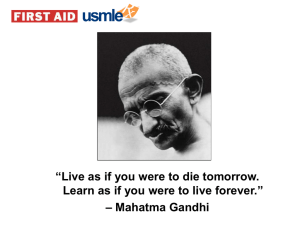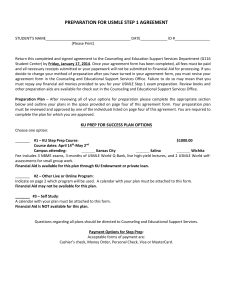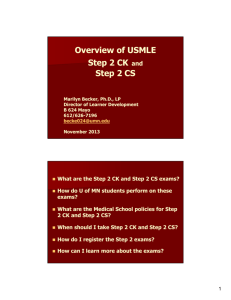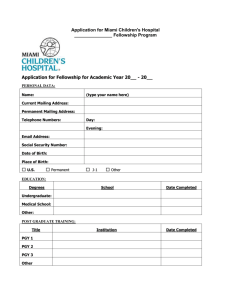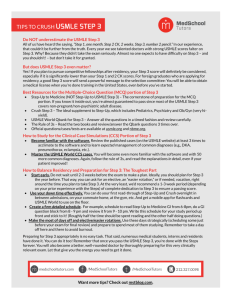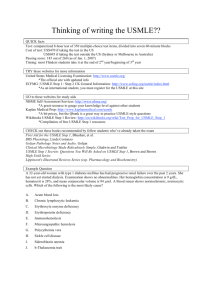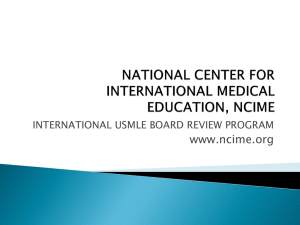How to Pass the USMLE Step 2 CK/3
advertisement
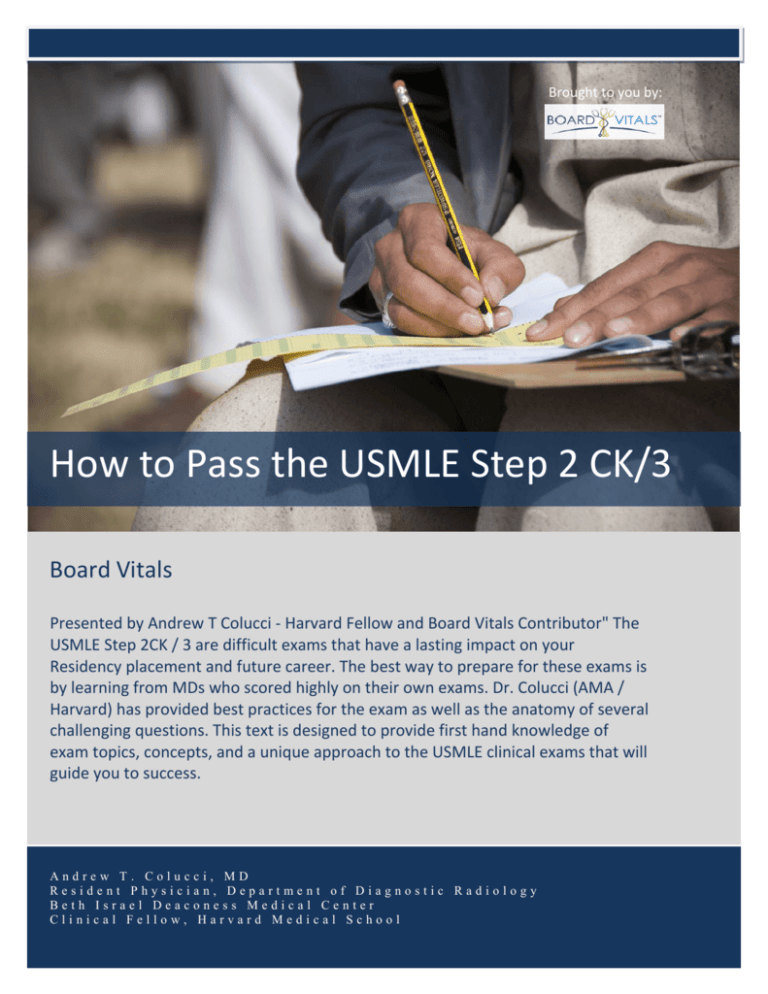
Brought to you by: How to Pass the USMLE Step 2 CK/3 Board Vitals Presented by Andrew T Colucci - Harvard Fellow and Board Vitals Contributor" The USMLE Step 2CK / 3 are difficult exams that have a lasting impact on your Residency placement and future career. The best way to prepare for these exams is by learning from MDs who scored highly on their own exams. Dr. Colucci (AMA / Harvard) has provided best practices for the exam as well as the anatomy of several challenging questions. This text is designed to provide first hand knowledge of exam topics, concepts, and a unique approach to the USMLE clinical exams that will guide you to success. Andrew T. Colucci, MD Resident Physician, Department of Diagnostic Radiology Beth Israel Deaconess Medical Center Clinical Fellow, Harvard Medical School How to Pass the USMLE Step 2 CK/3 Table of Contents Introduction ...............................................................................................................3 The Importance of the USMLE Step 2CK + 3 .................................................................4 Medical Licensing .....................................................................................................................................................4 Residency Admission ..............................................................................................................................................5 NRMP Data ..................................................................................................................................................................5 The Exams ..................................................................................................................8 USMLE Step 2 – Clinical Knowledge .................................................................................................................8 (1) Exam Details ............................................................................................................................................................ 8 (2) Content Overview .................................................................................................................................................. 8 USMLE Step 3 .............................................................................................................................................................9 (1) Exam Details ............................................................................................................................................................ 9 (2) Content Overview ................................................................................................................................................10 Preparation .............................................................................................................. 11 USMLE Step 2CK..................................................................................................................................................... 11 Mock Study Schedule (4-week length) ......................................................................................................... 13 USMLE Step 3 .......................................................................................................................................................... 14 Question Strategy ..................................................................................................... 15 General Approach .................................................................................................................................................. 15 Sample Question #1 – USMLE Step 2CK ....................................................................................................... 16 Sample Question #2 – USMLE Step 3 ............................................................................................................ 18 Sample Question #3 – USMLE Step 3 ............................................................................................................ 20 2 How to Pass the USMLE Step 2 CK/3 boardvitals.com How to Pass the USMLE Step 2 CK/3 Introduction Medical school provides us all with an abundance of challenges. Seemingly gargantuan tasks such as learning how to take a history and conduct a physical exam, performing a proper dissection, memorizing hundreds of pathophysiologic processes and their treatments, and caring for critically ill patients. Perhaps the only comparable task is the transition from the insulation of medical school to the blistering reality of taking care of your own patients as medical intern. That being said, the USMLE Step 1, 2, and 3 examinations represent perhaps the single biggest cumulative demonstration of one’s academic prowess required to advance through the ranks of the medical training pathway. How to Pass the USMLE Step 2 CK/3 is aimed at medical students entering their clinical years, PGY-1 interns, and international medical graduates who are preparing to take these examinations over the course of the next year or so. There is an overwhelmingly large amount of information available online and elsewhere which can help you to learn about Step 2CK and 3, including the content and format of these tests, as well as advice regarding how best to prepare for them. I’ve consolidated what I consider to be the highlights and summary points of this information, for your review. I’ll first set the stage about the importance of these examinations. Next, we’ll review the topics covered, as well as the overall length and format of the examinations. We’ll touch on a general approach towards preparation for these exams, and finally discuss several sample multiple-choice questions which reflect the content and format of the USMLE Step 2CK and Step 3 exams. My aim is to provide timely, useful advice in a quick and easy to read format. Best of luck with these examinations, and recognize that they are but a necessary step towards the independent practice of clinical medicine. Andrew T. Colucci, MD boardvitals.com How to Pass the USMLE Step 2 CK/3 3 The Importance of the USMLE Step 2CK + 3 Medical Licensing When considering the motivation behind studying hard and performing well on the USMLE Step 2CK and 3, let’s begin with the obvious. These examinations, in addition to the USMLE Step 1 and 2CS, must be passed in order to practice medicine independently. When you begin your post-graduate medical education as an intern/resident, your training institution will provide you with a limited medical license. This license, which must be renewed each year, allows you to practice supervised medicine within the confines of your training hospital/institution. At the completion of your post-graduate training, you will need to apply for a full medical license, granted by the state medical boards. These initial applications are lengthy, expensive, and time consuming. Successful completion of all USMLE Step exams are but one of the many components to a successful application. Given the length of this application process, many residents choose to obtain their full medical license during residency, thereby saving them the extra hassle later on in their career. Additionally, a full medical license is typically required to moonlight as a resident or fellow, particularly outside of the confines of your home institution. Given the extremely high (and rising) cost of medical school and the average student loan debt, moonlighting provides the opportunity to earn extra income while still in residency. In this way, early and successful completion of all USMLE Step exams can provide both a mental and financial boost of confidence. 4 How to Pass the USMLE Step 2 CK/3 boardvitals.com Residency Admission Of course, the aforementioned considerations only become relevant once you have started your post-graduate training. Prior to this, one must first gain acceptance to their desired residency program. As medical school class sizes grows and new medical schools are opened around the country, the bottleneck in the medical education process is beginning to move from medical school admissions to residency admissions. Therefore, particularly for students applying to competitive specialties and International Medical Graduates, it is essential to apply with a complete and impressive complement of credentials. Your scores on the USMLE Step 2CK exam (as well as the Step 3 exam, for International Medical Graduates) will help to strengthen your applications in two important ways. First, they will help to offset a weaker USMLE Step 1 score. In this way, they can balance your application, demonstrating both your clinical knowledge and your ability to perform highly on standardized examinations (which is comforting to residency program directors who anticipate you taking specialty-specific board exams while in residency). In addition, high marks on the USMLE Step 2CK and 3 can solidify your application in the event that you have already scored well on the USMLE Step 1 exam. By repeatedly performing at a high level on these exams, you will demonstrate your consistency and sustained focus to the increasingly selective residency admissions committees. NRMP Data To reinforce the points above regarding increasingly selective residency admissions and the importance of your USMLE Step 2CK score, let’s briefly review several important data points. The National Resident Matching Program (NRMP, often referred to as the “Match”) is the organization that has developed an electronic program that attempts to fill annual residency slots with the applicants best suited for those positions. The details of this process are beyond the scope of this article – suffice it to say that the program is multifaceted and complex. In addition to providing this yearly matching service, the NRMP also publishes data on the characteristics of their applicants each year. This document is referred to as “Charting Outcomes in the Match”, and is currently in its fifth edition (published in 2014). boardvitals.com How to Pass the USMLE Step 2 CK/3 5 In 2012, the NRMP conducted a survey of approximately 1,300 residency program directors across the nation and throughout all medical specialties. They asked the program directors to comment on which applicant factors they took into consideration when choosing to rank applicants to their residency program. As you can see from the results (summarized in the graph below), 70% of program directors cited USMLE Step 2CK scores as an important factor for the ranking of applicants. NRMP Program Director Survey Results, 2012 6 How to Pass the USMLE Step 2 CK/3 boardvitals.com Lets consider the four other items listed as applicant characteristics that are “more important” than your USMLE Step 2CK score. The most weight is given to scores on the USMLE Step 1, as one might expect. By the time you are studying for Step 2CK, however, you have already completed Step 1 and your score is final – this factor cannot be altered. Your personal statement, while important, is something that you will likely work on for several hours in the months preceding your application to residencies. Again, this is not an objective factor that you can significantly alter at this point in time. Finally, your clerkship grades and letters of recommendation are highly subjective and tied to one another. Saying that these are important components of one’s application to residency is essentially the same as saying that a strong performance in the second half of medical school is important! Therefore, we are left with the fact that at this point in your medical school career, your performance on the USMLE Step 2CK is the single objective measurement of your clinical knowledge that can be proactively improved upon prior to your application for residency. To drive the point home, let’s look at a second graph from the 2012 NRMP Program Director Survey regarding the USMLE Step 2CK examination. NRMP Program Director Survey Results, 2012 On the left, you can see that 80% of all surveyed residency programs require that applicants have taken the USMLE Step 2CK examination prior to applying for residency, in order to be considered for selection. Furthermore, almost half of the survey programs stated that they have a minimum target score that the applicant must exceed to move forward with consideration. On the right, we see that 32% of surveyed residency programs will never even consider applicants who have failed the USMLE Step 2CK examination on their first attempt, regardless of their subsequent scores on repeat attempts. boardvitals.com How to Pass the USMLE Step 2 CK/3 7 The Exams USMLE Step 2 – Clinical Knowledge (1) Exam Details The United States Medical Licensing Examination Step 2 Clinical Knowledge (USMLE Step 2CK) is a single-day examination containing 350 multiple-choice questions divided into eight 60-minuted testing blocks. The exam is given over the period of a single, 9-hour testing day. The exam begins with a 15-minute tutorial, which can be skipped to allow for extra break time. In addition to this optional tutorial, examinees are also given 45 minutes of break time. American medical students typically take the USMLE Step 2CK examination during the spring of their third year, or the fall of their fourth year. Many American medical schools require the successful completion of Step 2CK as a requisite for graduation. International medical graduates typically complete all of their USMLE examinations prior to applying for an American residency position. (2) Content Overview Whereas the USMLE Step 1 examination focused on the basic sciences and the relevant foundation that they form beneath all of medicine, Step 2CK shifts towards a more clinical focus. Purely basic science questions are few and far between, and are replaced with clinical vignettes asking you to discern the first step towards proper diagnosis or treatment. The specific content is broken down as follows: 8 How to Pass the USMLE Step 2 CK/3 boardvitals.com USMLE Step 2CK – Content Description and General Information USMLE Step 3 (1) Exam Details The United States Medical Licensing Examination Step 3 (USMLE Step 3) is a 2day examination. The first day involves 256 multiple-choice questions divided into six 60-minuted testing blocks. Some of these multiple-choice questions include sample pharmaceutical advertisements or research abstracts. A 5-minute optional tutorial and 45 minutes of allotted break time accompany the six 1-hour long testing blocks, summing to a 7-hour testing day. The second day of testing for Step 3 is longer, requiring up to 9 hours in total. Following a 5-minute optional tutorial, examinees are next presented with 198 multiplechoice questions divided into six 45-minute blocks. Next, a 7-minute tutorial is provided to introduce the examinee to the Primum Computer-based Case Simulation (CCS). Following this orientation, there are 13 case simulations provided, each with a 10- or 20minute time limit. A total of 45 minutes is provided for break time. boardvitals.com How to Pass the USMLE Step 2 CK/3 9 American medical students typically take the USMLE Step 3 examination during their intern year (PGY-1), or the first year of their residency (PGY-2). As with the USMLE Step 2CK, international medical graduates typically complete all of their USMLE examinations prior to applying for an American residency position. (2) Content Overview The USMLE Step 3 essentially picks up where the USMLE Step 2CK left off. The overarching focus is on clinical medicine, with many questions asking about the next best step in clinical management, including prompt diagnosis and appropriate treatment. The breadth of tested subspecialty medical content is largely similar to that of Step 2CK (see above). Per the USMLE, successful completion of Step 3 is necessary, though not sufficient, towards the independent and unsupervised practice of clinical medicine. 10 How to Pass the USMLE Step 2 CK/3 boardvitals.com Preparation USMLE Step 2CK As we’ve touched on, the Step 2CK examination evaluates your competency in the clinical sciences. In this way, it is a cumulative evaluation of all clinical rotations seen throughout your third year. Therefore, “studying” for Step 2CK truly begins on our first day of MS3 (third year). The long view would suggest that you study along the way, attempting to learn the testable material while you are on each relevant rotation. I’d typically recommend spending the first few days or week on each new rotation becoming accustomed to the workflow, the people, the common diseases, etc. Once you are up and running, however, I’d recommend doing some high-yield reading and Qbank practice questions along the way. This will help to both solidify your clinical knowledge for the long run, but also to prime you for the focused Step 2CK studying which will occur closer to the exam date. At some point in your third year of medical school, you should decide how much dedicated time you intend to block off for focused study leading up to the exam. For most students, this is typically 4-6 weeks, and we’ve provided an example study schedule below. Rather than utilizing separate review books for each study topic, I’d recommend choosing one (or two) highly rated composite Step 2CK review book. This review text, combined with a high-yield practice question bank, appears to be the most popular and successful approach towards Step 2CK exam preparation. Which textbook(s) to use? There are several well-known and highly rated sources. First Aid for the USMLE Step 2 CK provides a very good review of all tested subject areas, and is the most commonly recommended text. If you enjoyed First Aid for the USMLE Step 1, I’d suggest continuing along this path with the Step 2CK version. Board and Wards is often considered to be even higher yield than First Aid, and is perhaps the single highest yield review book for the CK. Additional options include Crush Step 2: The Ultimate USMLE Step 2 Review and USMLE Step 2 Secrets, both of which cover the exact same content in different formats, with Secrets being slightly more detailed. boardvitals.com How to Pass the USMLE Step 2 CK/3 11 To become proficient at performing well on timed, computerized exams challenging you with 300-400 multiple-choice questions on the clinical sciences, one is best served by unrelenting practice. This is where online questions banks (Q-banks) come into play. Which one is best? That is an oft-debated issue, with several old stalwarts and several new contenders entering the field. USMLEWorld and Kaplan have been around for years and offer large banks of practice questions that have been utilized by thousands of medical students. Newer entries into the market, such as BoardVitals, are poised to offer equally or higher quality Q-banks at a more affordable price given their budding reputation. Regardless of the practice question bank that you end up selecting, it is imperative to meticulously scrutinize each practice question and subsequently read the answer explanation until you understand the concept being tested. It is imperative to meticulously scrutinize each practice question and subsequently read the answer explanation until you understand the concept being tested. There is a strong, statistically significant correlation between the number of practice questions a student does and their performance on the exam. As a writer for boardvitals.com, I strongly endorse the product and think that it is a strong conceptual review of the topics you need to know. Take as many practice questions as you can and as the exam approaches start taking them in timed mode. 12 How to Pass the USMLE Step 2 CK/3 boardvitals.com Mock Study Schedule (4-week length) I’d recommend dividing the days leading up to the exam into the multiple different tested subjects and sub-topics. Each day, focus on the relevant review textbook chapters and the Q-bank practice questions that test this material. For example, if you chose to use First Aid for the USMLE Step 2 CK for your central review text, read its chapters on psychiatry, biostatistics, and ethics on the first day. Break up this reading by doing the corresponding 100-200 practice questions on the same topics found with the Q-bank of your choosing. Be sure to build time into this month-long study schedule to catch-up, as you will surely need it. I’d also strongly recommend taking several full-length practice examinations to get the hang of the exam’s pacing. Towards the end of the month, after your initial review of the material is complete, you can then can go back and rapidly review the highest-yield material again for maximum short-term retention immediately preceding the exam. A sample, day-by-day breakdown of subjects is as follows: Day 1 – Psychiatry, Biostatistics, Ethics Day 2 – General Internal Medicine #1 Day 3 – General Internal Medicine #2, Endocrinology Day 4 – Neurology, Ophthalmology Day 5 – Cardiology Day 6 – Pulmonology Day 7 – Catch up Day #1 Day 8 – Renal Day 9 – MSK, Rheumatology, Orthopedics Day 10 – Hematology/Oncology #1 Day 11 – Hematology/Oncology #2 Day 12 – Gastroenterology Day 13 – Catch up Day #2 Day 14 – Full-length Exam #1 – Recommend a practice NBME exam. Day 15 – Infectious Disease #1 Day 16 – Infectious Disease #2 Day 17 – Dermatology Day 18 – Emergency Medicine + Surgery Day 19 – Catch up Day #3 Day 20 – Full-length Exam #2 – Recommend a practice NBME exam. Day 21 – OB/GYN Day 22 – Pediatrics #1 Day 23 – Pediatrics #2 Day 24 – Catch up Day #3 Day 25 – Full-length Exam #3 – Recommend a practice NBME exam. Day 26 – Rapid review #1 – skim through your central textbook, and quickly repeat the relevant Q-bank practice questions, paying particular attention to those which you continue to answer incorrectly. Day 27 – Rapid review #2 (as above) Day 28 – Rapid review #3 (as above) Day 29 – Rapid review #4 (as above) Day 30 – Take the exam. boardvitals.com How to Pass the USMLE Step 2 CK/3 13 USMLE Step 3 The USMLE Step 3 examination has historically been given the lowest ranking of importance between the three USMLE Step examinations (or four exams, if you count USMLE Step 2CS). In fact, the old adage has been “two months for Step 1, two weeks for Step 2, and a #2 pencil for Step 3”. The reasoning behind this is likely multifactorial. First, as the USMLE Step 3 exam is generally taken towards the end of one’s PGY-1 year, it bears no weight on an American Medical Graduate’s residency placement (although fellowship is another matter). Similarly, since many will be studying for Step 3 during their intern year, there are simply not enough hours in the day to complete one’s clinical work, churn through an exhaustive exam preparatory regimen, and get enough sleep! To make matters worse, the selection of available review textbooks is significantly weaker that what is found for Step 1 and Step 2CK. Crush Step 3 is the fastest read, but it’s skeletal and full of knowledge holes. It is, however, the only book that’s quick enough to blaze through in a couple of short weeks. First Aid for the USMLE Step 3 is simply not that great of a book, and resembles the earlier entries in the series in name alone. Master the Boards: USMLE Step 3 is probably the most comprehensive book, but there’s no way that most interns will be able to get through it. Therefore, I personally recommend spending your precious free time during intern year working through multiple-choice questions and clinical cases via an online question bank of your choosing. As with Step 1 and Step 2CK, there are many choices available to you, each with their inherent strengths and weakness. The options are likely familiar by now, and include USMLEWorld, Kaplan, BoardVitals, etc. Whichever question bank you decide to go with, use it to both solidify the knowledge that you gain while on service, in addition to honing your speed and precision with the electronic examination format. In addition, pay special attention to the practice clinical cases that replicate the Primum CCS cases on the real exam. This is a novel format that is only seen in Step 3, and takes some getting used to. 14 How to Pass the USMLE Step 2 CK/3 boardvitals.com Question Strategy General Approach Read each question carefully. It is important to understand what is being asked. Try to generate an answer and then look for it in the option list. Alternatively, read each option carefully, eliminating those that are clearly incorrect. Of the remaining options, select the one that is most correct. If unsure about an answer, it is better to guess since unanswered questions are automatically counted as wrong answers. Let’s take a look at several example USMLE questions, reproduced with permission from Board Vitals, Inc. boardvitals.com How to Pass the USMLE Step 2 CK/3 15 Sample Question #1 – USMLE Step 2CK A 64-year-old male presents to the ED with 2 hours of persistent right facial droop and slurred speech. He denies having ever had these symptoms before. His past medical history is positive only for hypertension that is well controlled with hydrochlorothiazide. On physical examination, you note an asymmetric smile and tongue deviation towards the right. Which of the following is the next most appropriate step in management? A) B) C) D) E) Head CT without Contrast Head CT with Contrast MRI Head CT Angiography Begin IV tPA Approach: This is an example of a very typical USMLE Step 2CK question. It presents a clinical vignette, giving varying degree of history and physical exam findings, and subsequently asks you to evaluate the next best step in management. This particular question relates to the prompt evaluation of a patient presenting with signs and symptoms of acute stroke, but who’s symptoms may also related to entities such as a transient ischemia attack (TIA) or hypertensive intraparenchymal hemorrhage. The first step is to quickly read through the clinical vignette, mentally summarizing the findings and formulating a differential diagnosis as you go. Then, encounter the question stem itself and attempt to discern the correct answer based on your differential and working knowledge. If you look down and identify your preferred answer among the given answer choices, it is likely correct and you should select it. If the answer is not readily apparent at this point, however, you can read through the various answer choices and attempt to reason through each possibility, arriving at the answer choice most likely to be correct. Failing this, simply mark your best guess and move on. Answer: A. – This patient is presenting with signs and symptoms of acute stroke, and is within the 3-hour window for intravenous tPA administration. However, the patient should be evaluated for any contraindications to tPA, including hemorrhagic stroke, subdural hematoma, subarachnoid hemorrhage, etc. To this end, a non-enhanced head CT remains a critical and efficient way to exclude intracranial hemorrhage upon presentation with symptoms of acute cerebral ischemia. 16 How to Pass the USMLE Step 2 CK/3 boardvitals.com Choice B – A contrast-enhanced head CT is a suboptimal examination in the evaluation of acute stroke, as the presence of contrast can resemble free intracranial hemorrhage and thus confound the evaluation. Choice C – MRI head is an exquisitely sensitive examination for the detection of cerebral ischemia. However, it is more time consuming, specialized, and expensive. For patients presenting with definitive clinical signs and symptoms of acute ischemia, treatment can begin following the exclusion of hemorrhage via non-enhanced CT alone. Choice D – CT angiography (CTA) can be utilized to evaluate for vertebral artery and carotid artery stenosis and dissection, in addition to providing information regarding specific intracranial arterial occlusion. However, as with an enhanced CT examination, CTA alone can confound attempts to exclude intracranial hemorrhage. Choice E – As discussed above, the patient is presenting within the 3-hour time window (4.5 hours in certain situations) for tPA administration. However, prior to giving a potent thrombolytic, intracranial hemorrhage and mass must be excluded by imaging. boardvitals.com How to Pass the USMLE Step 2 CK/3 17 Sample Question #2 – USMLE Step 3 A 36-year-old man is brought in to a psychiatrist by his sister because she is concerned about his behavior since the death of their mother two months ago. She states that he has always been a “loner” and preferred being by himself than socializing with others. His social isolation had resulted in him being “socially awkward,” as described by his family, however, two months ago, when she told him that their mother died, he showed little emotion and attended her funeral in jeans and a dirty T-shirt, which upset the rest of their family. When asked about it, he shrugged and said he was in a hurry to get to the funeral and “just left the house with what I had on at the time.” The patient does not speak during the interview, allowing his sister to speak on his behalf. His sister insists that he has “always been like this,” being a quiet and complacent child who had no interest in playing with other children. He currently lives alone and spends his time repairing and building electrical appliances and his sister is worried that his self-imposed isolation is making it “impossible for him to interact with other people normally.” Which of the following is the most likely diagnosis? A) Schizoid personality disorder B) Schizophrenia C) Social anxiety disorder D) Depressive disorder E) Asperger’s Syndrome Approach: This sample question demonstrates the similarity that exists between many USMLE Step 2CK and Step 3 multiple-choice questions. Namely, the focus remains purely clinical. This question is a first order question asking you to essentially name the diagnosis described within the clinical vignette. As with the previous question, the best approach is to formulate a differential diagnosis as reading through the clinical vignette. Subsequently, narrow this differential down, think about the most likely diagnosis, and find your preferred answer from the listed answer choices. Failing this, read through all listed answer choices and attempt to work through the various possibilities to arrive at the most likely correct answer. Answer: A. – Since this patient’s behavior has been present since childhood (according to his sister) and persistent in a range of contexts, this patient is most likely exhibiting symptoms of a personality disorder. Schizoid personality disorder, especially, is characterized by a lack of interest in forming social relationships and a preference for a solitary lifestyle, secrecy, emotional coldness, and apathy. 18 How to Pass the USMLE Step 2 CK/3 boardvitals.com Choice B – Although the early stages of schizophrenia may have similar features as schizoid personality disorder, there would be mention of a period of more normal functioning at some point in the past. This patient has been showing symptoms since childhood, and his symptoms are predominantly consistent with avoidance of social interactions, than with psychotic symptoms. Choice C – anxiety disorder is characterized by a fear of social situations and, in particular, speaking publicly. This fear is grounded in the idea that a person might embarrass themselves by speaking, and thus, they develop a fear of having to speak in public or in social situations. There is also a fear of others being able to tell that the person is nervous when speaking, especially in cases where a person cannot hide the physical symptoms of their fear (hands are shaking, voice is shaking, blushing, etc.), and this only compounds the cycle of fear. In social anxiety, there may actually be a genuine desire to socialize, but the person is inhibited by fear, rather than a lack of interest. This patient is not afraid of social situations; he simply is not interested in engaging in them. Choice D – Depression would occur with a more acute onset and there would be a previous period of normal functioning expected. In this patient, his behavior was consistent throughout his childhood and was not marked by any particular time of “normal functioning” with regards to socializing. This does not mean, however, that patients with schizoid personality disorder cannot be depressed. In fact, individuals with personality disorders are more likely to suffer from depression or other affective disorders. Choice E – Asperger’s syndrome and schizoid personality disorder are similar in that they both manifest as difficulty socializing at an early age, however, in Asperger’s, there may also be mention of restricted, repetitive patterns of interests and behaviors, as it is part of the Autism spectrum of disorders. In Asperger’s, patients have impairments in nonverbal communication, such as an inability to make or maintain eye contact, or impaired or unusual prosody; these features are not part of the schizoid personality disorder profile. Further, patients with schizoid personality disorder may also have conduct disorder, better social adjustment as they get older, and a slightly increased risk of developing schizophrenia. boardvitals.com How to Pass the USMLE Step 2 CK/3 19 Sample Question #3 – USMLE Step 3 A 58-year-old female visits her physician for routine labs and health clearance documentation for international travel. She currently has no complaints. She is not taking any medications, does not smoke, and states that she drinks “socially” approximately 6 nights a week. She says she also enjoys a “nightcap,” which is one to two glasses of wine before bed every night. Physical exam is unremarkable. Complete blood count reveals an MCV of 72, white cell count of 4,500/mL, and platelet count of 630,000/mL. Which of the following is the most likely cause of this patient’s thrombocytosis? A) Iron-deficiency anemia B) Anemia of chronic disease C) Chronic myelogenous leukemia D) Sideroblastic anemia E) Essential thrombocytosis Approach: We’ll explore an alternative approach with this question. In an attempt to save time and speed up your test taking, you can start off a question by reading the question stem (typically the last sentence of the vignette). Then, read through the five listed answer choices and keep this dynamic (namely, the relationship between the question and the answer choices) in your mind. Then, go back and read the vignette until you have enough information to identify the correct answer choice. At this point, stop reading, select the answer, and move on. Since many first- and even second-order questions can be answered without reading through the entire clinical vignette, this approach will save you time. However, the drawback is that you may miss a detail or two within the depth of the vignette, causing you to occasionally make a premature diagnosis. In this example, were you to try this alternative approach, you would start by reading the question stem. It asks about the specific cause for thrombocytosis in this patient. Five answer choices are listed, but only one of them causes thrombocytosis. Therefore, were you to know that iron-deficiency anemia is the only listed clinical syndrome that can also cause iron-deficiency anemia, you could select the correct answer choice without spending any time reading the rest of the clinical vignette. 20 How to Pass the USMLE Step 2 CK/3 boardvitals.com Answer: A. Iron-deficiency anemia. – Of the given choices, only iron-deficiency anemia is associated with thrombocytosis, or elevated platelet count. The exact mechanism is unknown, but it may be due to a chemical overlap between the structures of thrombopoietin and erythropoietin. Therefore, a compensatory increase in RBC production (to respond to the iron-deficiency anemia) will lead to an increase in platelet production as well because the increased erythropoietin may also induce platelet production (since its structure is similar to thrombopoietin). Choice B – Anemia of chronic disease would not lead to a thrombocytosis, and there would be some indication of a disease or inflammatory process in the clinical picture. This patient currently has no symptoms. Choice C – Chronic myelogenous leukemia (CML) would lead to a high, rather than normal, white blood cell count. This patient’s WBC count is within normal limits. The reference range for WBCs is between about 3,500 to 10,500 cells per microLiter for both men and women. Choice D – Sideroblastic anemia would not lead to a thrombocytosis. Choice E – Essential thrombocytosis would result in a platelet count that could reach millions per microLiter. This patient has 630,000 cells per microLiter, which is not high enough to qualify as essential thrombocytosis. It is still above the normal range, which would be a typical finding in iron-deficiency anemia. The reference range for platelets is between about 15,000 to 450,000 cells per microLiter for both men and women. Brought to you by Board Vitals boardvitals.com How to Pass the USMLE Step 2 CK/3 21
